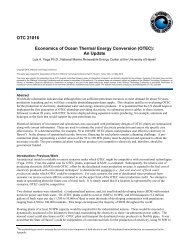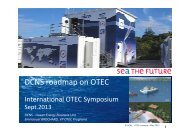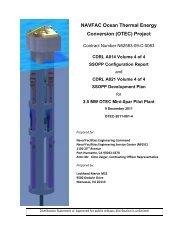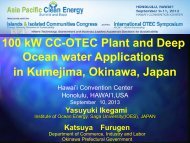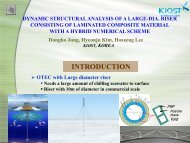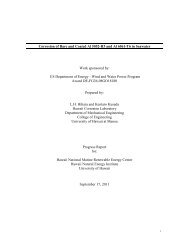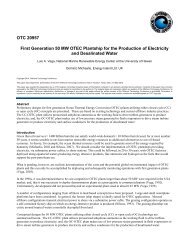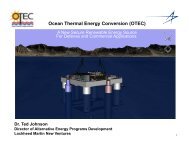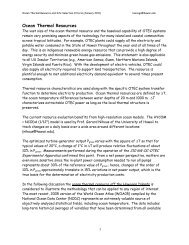MS Thesis R. Hager - Hawaii National Marine Renewable Energy ...
MS Thesis R. Hager - Hawaii National Marine Renewable Energy ...
MS Thesis R. Hager - Hawaii National Marine Renewable Energy ...
- No tags were found...
Create successful ePaper yourself
Turn your PDF publications into a flip-book with our unique Google optimized e-Paper software.
Note the diffraction parameter and wave slope are comparable to those studied by Koo andKim (2005). Two wave gages are used to monitor the wave height and frequency.Table 5. 1 Wave ConditionsT (sec) f (Hz) L (in.) H 1 /L H 2 /L B/L0.6 1.66 22.0380 0.0091 0.0363 0.27230.65 1.54 25.7230 0.0078 0.0311 0.23330.7 1.43 29.5550 0.0068 0.0271 0.20300.75 1.33 33.4710 0.0060 0.0239 0.17930.8 1.25 37.4190 0.0053 0.0214 0.16030.85 1.17 41.3630 0.0048 0.0193 0.14510.9 1.11 45.2830 0.0044 0.0177 0.13250.95 1.05 49.4670 0.0040 0.0162 0.12131 1 53.0110 0.0038 0.0151 0.11325.2 Experimental Set-upThe wave flume is 32 ft. (9.75m) long and 6 in. (15cm) wide. The first wave gage isapproximately 8’-3” from the wavemaker and 1’-6” from the body. The second wave gage isapproximately 20’-9”from the end of the wave flume and 1’-6” from the body. Two waveabsorbers are placed at the ends of the wave flume to minimize reflection. The set-up isdepicted in Figure 5.3. Positioning of the wave gages and body is dictated by the flume’sconstruction and reflection minimization.Figure 5. 3 Wave Flume Set-up85



